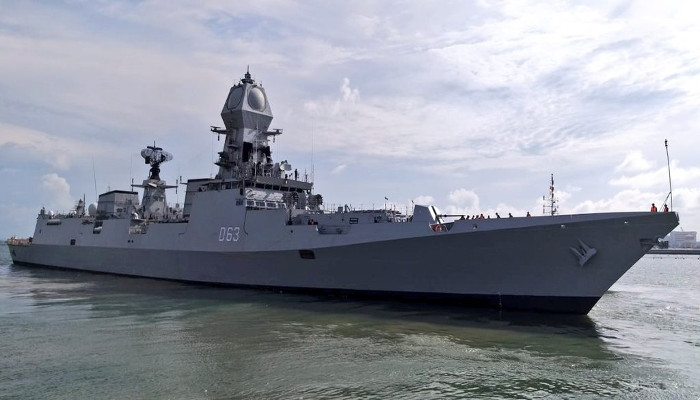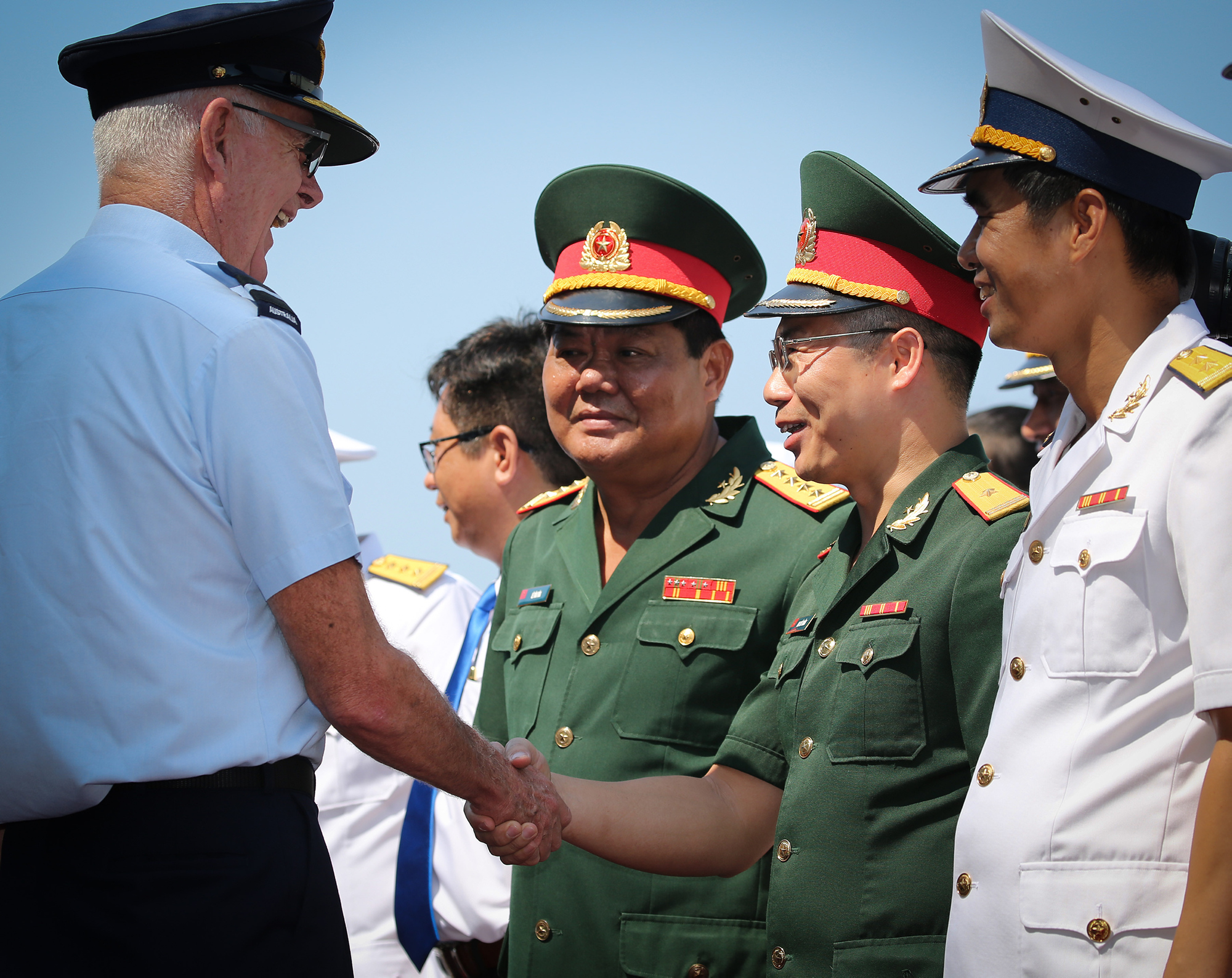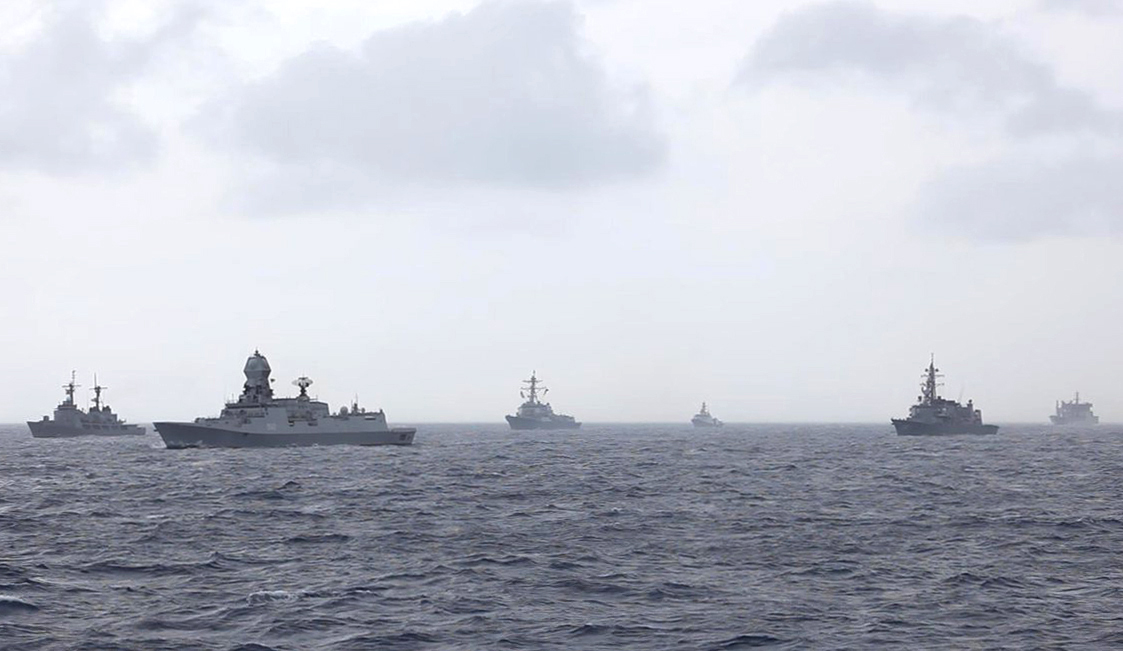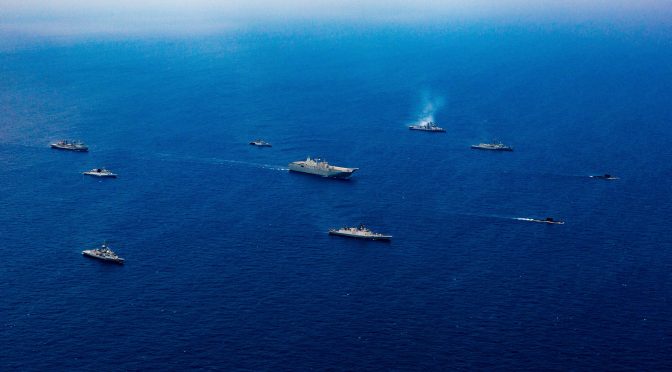By David Scott
From March to June 2019 naval diplomacy and an underlying strategic geometry was on show as India, Australia, France, and Japan deployed across and around the Indo-Pacific. All of them were involved in operating with each other, with the U.S., and with other actors in the region like Singapore, Vietnam, and the Philippines. Anti-submarine warfare (ASW) in particular was a recurring theme throughout the exercises.
Indian Deployments
India carried out significant deployments in the Indian Ocean, in the shape of the AUSINDEX exercises with Australia in April and the VARUNA exercises with France in May. Both of these exercises were conducted with greater Indian strength amid implicit concerns over China.
The AUSINDEX exercise was conducted with Australia’s Indo-Pacific Endeavour 2019 Group and took place from 2–16 April. The exercises were described by the Indian Navy as “advanced warship drills.” Organized by the Eastern Fleet, the Indian Navy was represented by the multi-role destroyer INS Ranvijay, the multi-role stealth frigate INS Sahyadri, the missile corvette INS Kora, the ASW corvette INS Kiltan, and the submarine INS Sindhukirti. In addition, the Indian Navy sent Dornier maritime patrol aircraft, Hawk Advanced Jet Trainers, and P-8I ASW aircraft.
As these bilateral exercises with Australia were taking place in the Bay of Bengal, other bilateral exercises were being conducted elsewhere in the Indian Ocean. On 15 April, anti-submarine exercises were also carried out near Diego Garcia between an Indian P-8I ASW aircraft, based at Indian Naval Station Rajali in southern India, a U.S. P-8A Poseidon maritime patrol aircraft, and the U.S. guided-missile destroyer USS Spruance. This was the first ASW drill since India and the U.S. signed the Communications, Compatibility and Security Agreement (COMCASA) in September 2018. In turn, on 24 April, two Indian Navy P-8I ASW aircraft and an Indian submarine carried out anti-submarine drills in the Arabian Sea with two Japanese P-3C Orion maritime patrol aircraft. This marks the third iteration of the bilateral Indo-Japanese ASW exercise.
The VARUNA exercises with France’s Task Force 473 were conducted in two phases. Phase 1, from 1–10 May in the Arabian Sea, involved India’s aircraft carrier INS Vikramaditya, the destroyer INS Mumbai, the frigate INS Tarkash, the submarine INS Shankul, and the fleet tanker INS Deepakh carrying out various exercises, including anti-submarine drills. This was the largest ever VARUNA exercise. Phase 2 from 22–25 May witnessed another Indian submarine, INS Kalvari, carrying out submarines drills with a French submarine off the Djibouti coast by the Bab el-Mandeb chokepoint between the Red Sea and Gulf of Aden.
During this time the guided-missile destroyer, INS Kolkata and the replenishment ship INS Shakti were dispatched for eastern duties from April to May 2019. Various cooperative initiatives were pursued. They moored from 21–23 April at Qingdao for China’s International Naval Review, and the Indian Navy was clear that “the visit of Indian Navy’s most potent destroyer and versatile fleet support ship showcases India’s prowess, reach and sustainability.” From Qingdao the Indian ships went to Busan for an extended friendly port call and discussions with the South Korean Navy from 28–30 April, before undertaking cooperative ADMM-Plus maritime exercises off South Korea from 1–2 May and then in the South China Sea from 9–12 May. On its completion, the Indian vessels went down to Singapore to attend the closing ceremony of the ADMM-Plus exercises on 14 May and participate (alongside HMAS Canberra) in the International Maritime Defense Expo 2019 in Singapore from 16–18 May.
However, more controversial deployments were witnessed in the South China Sea by INS Kolkata and INS Shakti. Firstly, they carried out bilateral maritime exercise with the Vietnamese Navy from 13–16 April at Cam Ranh Bay, a “significant step” for the Indian Navy; the first having been initiated in 2018. Secondly, on returning to the South China Sea they participated in a week-long “Group Sail” including formation maneuvering drills from 3-9 May with Japan’s Indo-Pacific Deployment (IPD19) carrier group, the U.S., and the Philippine navies. Thirdly, from 19–22 May the two Indian vessels, joined by an Indian P-8l long range surveillance plane, carried out anti-submarine and anti-air SIMBEX exercises in the South China Sea with the Singaporean Navy and Air Force, with the Indian Navy keen to emphasize that “for SIMBEX 2019, the IN has deployed its finest assets.”

Australian Deployments
Australia’s centerpiece deployment formation known as Indo-Pacific Endeavour 2019 (IPD19), now in its third iteration, was conducted from February to May 2019. Defense Minister Christopher Pyne explained that “in 2019, the focus of Indo-Pacific Endeavour will be the Indian Ocean, in recognition of the Indian Ocean region’s rapid economic transformations and increasing strategic competition” – a reference to the growing presence of China, and of growing India-China and U.S.-China friction. The political stress given by Pyne was significant, that “engagement with India – a key strategic partner for Australia – will be the cornerstone of Indo-Pacific Endeavour 2019.”
The naval group was led by Australia’s flagship, the helicopter landing carrier HMAS Canberra; supported by the guided missile frigate HMAS Newcastle, the anti-submarine/anti-aircraft frigate HMAS Parramatta, and the resupply tanker HMAS Success. The carrier group’s first port of call was Sri Lanka on 22 March, where the Canberra and Newcastle went to Colombo and the Parramatta and Success went to Tricalomone. This was Australia’s biggest ever naval visit to Sri Lanka, and perhaps represented a tacit welcome to Sri Lanka’s switch from its overtly pro-China stance under former President Raja Rajapaksa.
Australia’s eyes then turned to India, and the AUSINDEX 2019 exercise running from 2–16 April. This was the third such bilateral exercise between Australia and India, the largest ever, and which involved ASW drills for the first time. The IPE group was joined by the submarine HMAS Collins and an Australian P-8A maritime patrol aircraft. After the event, Australia’s High Commissioner to India, Harinder Sidhu considered AUSINDEX 2019 to have been “a landmark moment in our relationship […] building the Australia-India Partnership in the Indo-Pacific.” Meanwhile HMAS Toowoomba was detailed for a six-day visit from 10–15 April to Chennai, the navy base headquarters of India’s Southern Command.
Subsequently, from 16–22 April, HMAS Toowoomba and the submarine HMAS Collins took part in quadrilateral exercises in the Bay of Bengal involving the French Task Force 473 headed by their aircraft carrier the FS Charles de Gaulle, the Japanese Indo-Pacific Deployment 2019 group lead by their helicopter carrier JS Izumo, and also featured the U.S. guided missile destroyer USS William P. Lawrence.
On 21 April, the Indo-Pacific Endeavour units reached Malaysia; HMAS Canberra and Newcastle visiting Port Klang, while HMAS Success visited Langkawi and then Port Klang. From 27–30 April HMAS Canberra and HMAS Newcastle paid supportive port calls to Phuket in Thailand, demonstrating humanitarian assistance capabilities. A small contingent of U.S. Marines embarked on the Canberra for the rest of the journey.
Australian units were then involved in the South China Sea, but from 13–16 May, HMAS Canberra was moored at Singapore, on show for the biannual International Maritime Defense Expo 2019 organized by the Singaporean Navy. Subsequently, on 18 May HMAS Canberra and Newcastle arrived at Jakarta to carry out further humanitarian work. HMAS Canberra’s return to Darwin, on the north Australian coast on 26 May marked the formal end of the IPE deployment, which Defense Minister Linda Reynolds was quick to emphasize that this was “Australia’s flagship maritime activity” at the Shangri La Dialogue on June 2.
In the South China Sea, the participation of HMAS Success in the replenishment of other vessels involved in the multinational ASEAN Defense Ministers Meeting Plus (ADMM-Plus) naval training exercise phase held in the Gulf of Thailand in early May was uncontroversial. More controversial was the deployment to Vietnam. From 7–10 May, HMAS Canberra and HMAS Newcastle docked in Cam Ranh, conducting a series of engagement activities and training exercises with Vietnamese counterparts. This was the first appearance of Vietnam on Australia’s IPE itineraries. In the South China Sea, both HMAS Canberra and Parramatta were trailed by Chinese warships, demanding prior notification of Australian transit (which Australia refuses to give as a matter of principle) with observers recording laser flashing from accompanying Chinese fishing vessels disrupting helicopter operations being carried out by HMAS Canberra. It was significant that on 20 May, returning from sanctions patrolling against North Korea in the East China Sea, the guided missile frigate HMAS Melbourne, along with the American guided-missile destroyer USS Preble, conducted a freedom of navigation operation (FONOP) near Scarborough Shoal in the South China Sea.

Coming over from the IPE19 task force, HMAS Parramatta was then joined by HMAS Melbourne and the submarine HMAS Farncomb to participate in the newly formed PACIFIC VANGUARD exercises, the first of its kind, held from 22–28 May off Guam with U.S., Japanese, and South Korean naval units. These involved live fire exercises, anti-air operations, and ASW drills. The Australian Navy fleet commander Rear Admiral Jonathan Mead stated that “Exercise Pacific Vanguard involved four likeminded regional partners working together to support our shared views of a free, open and prosperous Indo-Pacific.”
French Deployments
French Indo-Pacific deployments focused mostly around the Task Force 473 carrying out Operation Clemenceau across the Northern Indian Ocean and South China Sea from April to May. In terms of assets, Task Force 473 is France’s leading power projection battle group. The 2019 group core was made up of the Charles De Gaulle nuclear-powered aircraft carrier, the anti-air frigate FS Forbin, and the anti-submarine frigate FS Latouche-Tréville, joined by other French elements (and other nations) at various points. In terms of purpose, on 11 March France stated that “boasting assets related to freedom of navigation, the TF 473 is a politico-military tool, which will deploy in areas of strategic interest, from the Mediterranean to the Indo-Pacific.”
The Task Force was preceded from March–April by the Jeanne d’Arc Mission, comprising France’s second most powerful asset, the helicopter carrier FS Tonnerre, accompanied by the frigate FS La Fayette, which deployed down the African littoral from Djibouti to South Africa. President Macron had also warned about Chinese influence in the region during his own visit to Djibouti in March 2019, as he also had in his visit to New Caledonia in May 2018. Elsewhere, FS Vendémiaire’s transit of the Taiwan Strait on 6 April, on its way from New Caledonia to take part with the U.S. and Japanese navies in sanctions enforcement in the East China Sea against North Korea, attracted immediate Chinese ire, and the disinvitation of the Vendémiaire from attending China’s International Navy Review held at Qingdao on 23 April.
Escorted by the Australian frigate HMAS Ballarat, the French task force moved across the Gulf of Aden to the Arabian Sea, where it was joined by the multi-mission frigate FS Provence. There, on 25 April drills were carried out off the coast of Oman with the Canadian frigate HMCS Regina and tanker HMCS Asterix.
From 1–10 May, the Task Force was joined by the nuclear attack submarine FS Amethyste, to carry out VARUNA exercises with India in the Arabian Sea, off Goa and Karwar, which included live fire, anti-air, and ASW drills. This represented the largest ever France-India exercise, with each side fielding aircraft carrier battle groups. FS Amethyste then re-deployed westward to carry out submarine operations with India off the Djibouti coast, by the Bab el-Mandeb choke point between the Red Sea and Gulf of Aden.
Meanwhile the French carrier group had gone further eastward to the Bay of Bengal. First, the group escorts FS Forbin, FS Marne, FS Latouche-Treville, and FS Provence carried out ASW drills with the American submarine USS Hawaii on 14 May. Then from 16–22 May, substantive quadrilateral LA PEROUSE exercises, including live fire drills, were conducted by the whole Task Force Group with units from Australia, Japan, and the United States. Context for such operations were provided on 29 by the Ministry of Defense’s release of its paper France’s Defense Strategy in the Indo-Pacific, which argued that with such deployments “France seeks to cement its posture as a regional power of the Indo-Pacific.”
FS Forbin was dispatched to Vietnam from 28 May to 3 June, which included air defense exercises with the Vietnamese Navy. Simultaneously, the main group was dispatched from 28 May to 3 June to Singapore. On 3 June anti-submarine and anti-air exercises were carried out with the Singaporean Navy and Air Force. Further joint drills were carried out between Task Force 473 (without the Forbin) and the American amphibious assault ship USS Boxer in the Andaman Sea from 7–9 June, as the Task Group was returning back from Singapore via Goa and then Djibouti.
This Singapore sojourn overlapped with the Shangri-La Dialogue where France’s Defense Minister Florence Parly emphasized the role of the Task Force Group as a “mighty instrument of power projection” whose exercises with India, Australia, Japan, and the U.S. had exemplified the “emergence of an Indo-Pacific axis.” On board the Charles de Gaulle, Parly told the crew “you affirm our status as a maritime power” and “your presence in Singapore contributes to our influence in this key region.”
Japanese Deployments
Japan’s centerpiece deployment was its Indo-Pacific Deployment 2019 (IPD19) from 30 April to 10 July. The Japanese Navy (the Japanese Maritime Self Defense Force or JMSDF) stated its mission as being to “conduct joint exercises in the Indo-Pacific region with the navies and other armed forces of other countries to improve its tactical capabilities and strengthen its coordination with foreign forces.” This was the third iteration, following the previous helicopter carrier-led Indo-South East Asia Deployment (ISEAD) in 2017 and 2018. The 2019 IPD19 deployment centered on the helicopter carrier JS Izumo, accompanied by the destroyer JS Murasame. Both the Izumo and Kaga helicopter carriers are set for conversion to fixed wing F-35B aircraft operations, a conversion driven in part by China’s own aircraft carrier program.
The IPD19 had been immediately preceded on 24 April with two Japanese P-3C Orion maritime patrol aircraft carrying out ASW drills with two Indian Navy P-8I Long Range Maritime Reconnaissance (LRMR) ASW aircraft and an Indian submarine in the Arabian Sea. Southward, the destroyer JS Samidare carried out exercises in the Maldives on 24 April.
With regard to the IPD19 force, the Izumo and Murasame had originally planned joining the first phase of the ADMM-Plus exercises being hosted by South Korea on 1-2 May, as did India. However, the downturn in relations with South Korea led to Japan deciding to not join in the ADMM-Plus exercise. Instead from 1-7 May, the Japanese carrier group conducted drills for a week in the South China Sea with the U.S. (USS William P Lawrence), Indian (the destroyer INS Kolkata and the tanker INS Shakti) and Philippine (BRP Andres Bonifacio) navies. From 9–12 May the Japanese group was involved in Phase 2 of the ADMM-Plus exercises in the Gulf of Thailand, arriving in Singapore on the 13 May. Simultaneously, JS Samidare arrived in Manila for a three-day goodwill visit from 17–20 May.

Transiting Singapore, on 18 May the IPD group carried out exercises with the American guided missile destroyer USS William P. Lawrence in the Strait of Malacca. The Japanese group then joined up with the French Task Force 473, to carry out quadrilateral exercises from 19–22 May which also involved Australia’s Indo-Pacific Endeavour 2019 flotilla (the frigate HMAS Toowoomba and the submarine HMAS Collins) and America’s USS William P. Lawrence. Rear Admiral Hiroshi Egawa commented that “working with high-end navies, this exercise will contribute to peace and stability in the Indo-Pacific region”; while Japan’s Ministry of Defense argued that the navy “continues to strengthen further cooperation with U.S., France and Australia based on the Free and Open Indo-Pacific vision.” In the wake of the quadrilateral format, from 23–24 May the Japanese group carried out further bilateral operations with India’s stealth frigate INS Sahyadri, including tactical maneuvers and ASW exercises. This was followed by friendly port calls to Malaysia from 26–29 May.
Further out in the Western Pacific, the Japanese Navy dispatched JS Ariake and JS Asahi to participate in the PACIFIC VANGUARD exercises held off Guam from 22–28 May with U.S., Australian and South Korean units. Japanese participation with South Korean units was a useful umbrella to get over their ongoing bilateral coolness.
Pointed action was manifest from 10–12 June as the Izumo and Murasame were joined by another Japanese destroyer, JS Akebono, in drills in the South China Sea with the U.S. aircraft carrier the USS Ronald Reagan. Then the Izumo and Akebono conducted OPERATION KADEX interoperatibility drills from 13–15 June with Canada’s HMCS Regina and MV Asterix. It can be noted that these Canadian units had earlier exercised with the French Task force 473 in the Arabian Sea. Subsequently from 15–17 June, the Izumo and Murasame were moored at Cam Ranh Bay, a visit concluded by bilateral exercising with the Vietnamese Navy on 17 June. This extended South China Sea itinerary was concluded with the arrival of the Izumo, Murasame, and Akebono on 23 June at Muara port in Brunei, and on 30 June at Subic Bay in the Philippines, complete with further bilateral drills. The State Minister for Foreign Affairs, Kentaro Sonoura was clear that these South China Sea drills were there to foster “stable and secure trade and passage in the Indo-Pacific region which are precisely the core principles of Japan’s vision of a free and open Indo-Pacific.”
Overall Significance
The strategic geometry represented in these varied naval deployments was flexible, reflecting the varied bilateral networking and interrelated multilateralism that has come to predominate in the Indo-Pacific as countries respond to the growing presence and challenge of China across the Pacific and the Indian Oceans. New quadrilateral formats emerged across the Indo-Pacific from the various deployments in the shape of the France-Australia-Japan-U.S. drills in the Bay of Bengal, the Japan-India-U.S.-Philippine drills in the South China Sea, and the Australia-Japan-U.S.-South Korea drills in the Western Pacific. The U.S. “hubs and spoke” containment system has been replaced by a more diffuse crisscrossing “network” of arrangements that tacitly have China in mind.
David Scott is an Indo-Pacific analyst for the NATO Defense College Foundation, and regular lecturer at the NATO Defense College. A prolific writer on maritime geopolitics, he can be contacted at davidscott366@outlook.com.
Featured Image: A Task Group consisting of four ships and a submarine from the Royal Australian Navy, enhanced by a Royal Australian Air Force maritime patrol aircraft, are visiting India for AUSINDEX 2019, the major, bilateral Navy-to-Navy exchange between Australia and India. (Photo by: LSIS Steven Thomson, Australian Ministry of Defence)

